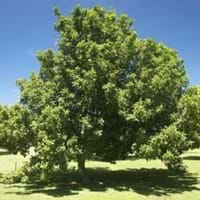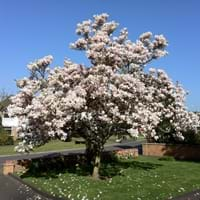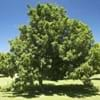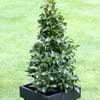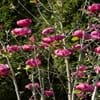Life Span
Perennial
Perennial
Origin
Hybrid origin
Hybrid origin
Types
Beaumont, Maroochy
Gwillimia, Manglietia, Kmeria
Number of Varieties
Not Available
Habitat
Not Available
Subtropical climates, Tropical regions
USDA Hardiness Zone
10-12
6-9
Sunset Zone
H1, H2, 9, 16, 17, 19, 20, 21, 22, 23, 24
Not Available
Habit
Oval or Rounded
Oval or Rounded
Flower Color
Pink, Light Pink
Purple, Pink, Light Pink, Rose
Flower Color Modifier
Bicolor
Bicolor
Fruit Color
Green, Chocolate
Brown
Leaf Color in Spring
Dark Green, Copper
Green
Leaf Color in Summer
Dark Green
Green
Leaf Color in Fall
Dark Green
Green, Yellow green, Sandy Brown
Leaf Color in Winter
Dark Green, Copper
Not Available
Plant Season
Spring, Summer, Fall, Winter
Spring, Summer
Sunlight
Full Sun
Full Sun, Partial Sun
Growth Rate
Very Slow
Medium
Type of Soil
Loam, Sand
Clay, Loam, Sand
The pH of Soil
Acidic, Neutral, Alkaline
Acidic, Neutral
Soil Drainage
Well drained
Well drained
Bloom Time
Early Spring, Spring, Late Winter
Spring, Late Spring
Tolerances
Not Available
Not Available
Where to Plant?
Ground
Ground
How to Plant?
Seedlings
Seedlings, Transplanting
Plant Maintenance
Medium
Medium
Watering Requirements
Requires regular watering
Prefer drip-irrigation instead of Over-head watering
In Summer
Lots of watering
Lots of watering
In Spring
Moderate
Moderate
In Winter
Average Water
Average Water
Soil pH
Acidic, Neutral, Alkaline
Acidic, Neutral
Soil Type
Loam, Sand
Clay, Loam, Sand
Soil Drainage Capacity
Well drained
Well drained
Sun Exposure
Full Sun
Full Sun, Partial Sun
Pruning
Remove branches, Remove damaged leaves, Remove dead leaves
Prune if you want to improve plant shape
Fertilizers
All-Purpose Liquid Fertilizer
Fertilize in late fall, fertilize in spring, Requires high amount of nitrogen
Pests and Diseases
Anthracnose, fungus, Mites, Scale, Thripes
Aphids, Bacterial Blight, Canker, Crown gall, Hoplia beetle, Leaf burn, Leaf spot, Mealybugs, Powdery mildew, Red blotch, Scorch, Soft scales, Thripes, Wetwood
Plant Tolerance
Drought
Not Available
Flower Petal Number
Not Available
Single
Fragrant Flower
Not Available
Yes
Foliage Texture
Coarse
Coarse
Foliage Sheen
Glossy
Matte
Attracts
Not Available
Not Available
Allergy
breathing problems, cramps, Diarrhea, Itchiness, Itchy eyes, Mouth itching, Nausea, Throat itching, Vomiting
Not Available
Aesthetic Uses
Showy Purposes
Showy Purposes
Beauty Benefits
Not Available
Treatment of Dark Spots
Environmental Uses
Air purification
Air purification
Medicinal Uses
Not Available
Alzheimer’s Disease, Anxiety, Cancer, Digestion problems, Liver problems, Menstrual Cramps, Respiratory Disorders, Weight loss
Part of Plant Used
Whole plant
Whole plant
Other Uses
Used As Food, Used as Ornamental plant
Used as Ornamental plant, Used for its medicinal properties
Used As Indoor Plant
No
Yes
Used As Outdoor Plant
Yes
Yes
Garden Design
Edible, Fruit / Fruit Tree, Shade Trees, Tropical
Feature Plant, Foundation, Shade Trees
Botanical Name
MACADAMIA 'Beaumont'
MAGNOLIA 'Alexandria'
Common Name
Macadamia
Alexandria Magnolia, Magnolia
In Hindi
Macadamia
हिम चम्पा
In German
Macadamia
Magnolienbaum
In French
Macadamia
magnolia
In Spanish
Macadamia
árbol de magnolia
In Greek
Macadamia
Magnolia δέντρο
In Portuguese
Macadamia
magnólia
In Polish
Macadamia
magnolia drzewa
In Latin
Macadamia
Magnolia lignum
Phylum
Magnoliophyta
Magnoliophyta
Class
Magnoliopsida
Magnoliopsida
Order
Proteales
Magnoliales
Family
Proteaceae
Magnoliaceae
Clade
Angiosperms, Eudicots
Angiosperms, Magnoliids
Tribe
Not Available
Not Available
Subfamily
Not Available
Not Available
Properties of Macadamia and Magnolia Tree
Wondering what are the properties of Macadamia and Magnolia Tree? We provide you with everything About Macadamia and Magnolia Tree. Macadamia doesn't have thorns and Magnolia Tree doesn't have thorns. Also Macadamia does not have fragrant flowers. Macadamia has allergic reactions like breathing problems, cramps, Diarrhea, Itchiness, Itchy eyes, Mouth itching, Nausea, Throat itching and Vomiting and Magnolia Tree has allergic reactions like breathing problems, cramps, Diarrhea, Itchiness, Itchy eyes, Mouth itching, Nausea, Throat itching and Vomiting. Compare all the properties and characteristics of these two plants. Find out which of these plant can be used as indoor plant. If you are interested to decorate your house and garden, find out aesthetic uses, compare them and select the plant which will beautify your surrounding. Along with beautification, try comparing medicinal and edible uses of Macadamia and Magnolia Tree and you can choose the plant having best and most benefits.
Season and Care of Macadamia and Magnolia Tree
Season and care of Macadamia and Magnolia Tree is important to know. While considering everything about Macadamia and Magnolia Tree Care, growing season is an essential factor. Macadamia season is Spring, Summer, Fall and Winter and Magnolia Tree season is Spring, Summer, Fall and Winter. The type of soil for Macadamia is Loam, Sand and for Magnolia Tree is Clay, Loam, Sand while the PH of soil for Macadamia is Acidic, Neutral, Alkaline and for Magnolia Tree is Acidic, Neutral.
Macadamia and Magnolia Tree Physical Information
Macadamia and Magnolia Tree physical information is very important for comparison. Macadamia height is 460.00 cm and width 300.00 cm whereas Magnolia Tree height is 460.00 cm and width 370.00 cm. The color specification of Macadamia and Magnolia Tree are as follows:
Macadamia flower color: Pink and Light Pink
Macadamia leaf color: Dark Green and Copper
Magnolia Tree flower color: Purple, Pink, Light Pink and Rose
- Magnolia Tree leaf color: Green
Care of Macadamia and Magnolia Tree
Care of Macadamia and Magnolia Tree include pruning, fertilizers, watering etc. Macadamia pruning is done Remove branches, Remove damaged leaves and Remove dead leaves and Magnolia Tree pruning is done Prune if you want to improve plant shape. In summer Macadamia needs Lots of watering and in winter, it needs Average Water. Whereas, in summer Magnolia Tree needs Lots of watering and in winter, it needs Average Water.
